LG01v2 -- LoRa Gateway User Manual

Table of Contents:
- 1. Introduction
- 2. Quick Start
- 3. Web Configure Pages
- 4. Build in Server
- 5. How to configure the Lora Gateway
- 6. OTA System Update
- 7. How users can access LG01v2 using serial USB
- 8. FAQ
- 9. Trouble Shooting
- 10. Supports
- 11. Reference
- 12. Order Info
- 13. Manufacturer Info
- 14. FCC Warning
1. Introduction
1.1 What is LG01v2
The LG01v2 is an open-source single channel LoRa Gateway. It lets you bridge LoRa wireless network to an IP network via WiFi , Ethernet or Cellular Network (via Optional 4G module). The LoRa wireless allows users to send data and reach extremely long ranges at low data rates.
LG01v2 is specially designed for peer-to-peer LoRa protocol instead of LoRaWAN protocol. The LG01v2 uses a single-channel LoRa module to minimize the deployment cost for a private p2p LoRa wireless network.
Note: The LG01v2 can't register and connect to the LoRaWAN server(Such as The Things NetWork, AWS, or Chirpstack..)
LG01v2 uses Open Source Linux system. User can modify the Linux part and develop customize software base on it. It has 1.2Ghz Quad-Core CPU , 4GB eMMC storage and 512MB RAM for most application.
LG01v2 supports remote management. System Integrator can easy to remote monitor the gateway and maintain it.
1.2 Specifications
Hardware System:
- CPU: Quad-core Cortex-A7 1.2Ghz
- RAM: 512MB
- eMMC: 4GB
Interface:
- 10M/100M RJ45 Ports x 1
- WiFi 802.11 b/g/n
Operating Condition:
- Work Temperature: -20 ~ 65°C
- Storage Temperature: -20 ~ 65°C
- Power Input: 5V, 2A, DC
1.3 Features
- Open Source Debian system
- Managed by Web GUI, SSH via WAN or WiFi
- Remote Management
- Auto-provisioning for batch deployment and management
- LoRa Gateway
- Built-in Node-Red local Application server
1.4 Block Diagram
1.5 LED Indicators
LG01-V2 has totally four LEDs, They are:
➢ Power LED : This RED LED will be solid if the device is properly powered
: This RED LED will be solid if the device is properly powered
➢ ETH LED : This RGB LED will blink GREEN when the ETH port is connecting
: This RGB LED will blink GREEN when the ETH port is connecting
➢ SYS LED : Undefined yet.
: Undefined yet.
➢ WIFI LED : This LED shows the WIFI interface connection status.
: This LED shows the WIFI interface connection status.
1.6 Button Intruction
LG01-V2 has a black toggle button, which is:
➢ Long press 4-5s : the gateway will reload the Network and Initialize wifi configuration
LED status: ETH LED will BLINKIND BULE Until the reload is finished.
➢ Long press more than 10s: the gateway will restore the factory settings.
LED status: ETH LED will SOLID BULE Until the restore is finished.
2. Quick Start
The LG01-V2 supports network access via Ethernet or Wi-Fi connection and runs without a network.
In most cases, the first thing you need to do is make the LG01-v2 accessible to the network.
2.1 Access and Configure LG01-v2
2.1.1 Find IP address of LG01-v2
Method 1: Connect via Ethernet with DHCP IP from the router
Connect the LG01-V2 Ethernet port to your router and LG01-V2 can obtain an IP address from your router. In the router's management portal, you should be able to find what IP address the router has assigned to the LG01-V2.
You can also use this IP to connect.

Method 2: Connect via LG01v2 Fallback IP
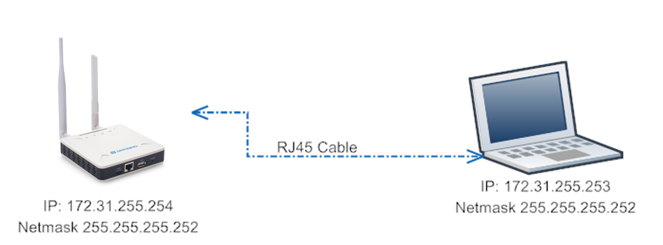
Steps to connect via fallback IP:
1. Connect the PC's Ethernet port to LG01v2's WAN port
2. Configure PC's Ethernet port has IP: 172.31.255.253 and Netmask: 255.255.255.252
Settings --> Network & Internet --> Ethernet --> Change advanced sharing options --> Double-click"Ethernet" --> Internet Protocol Version 4 (TCP/IPv4)
As in the below photo:
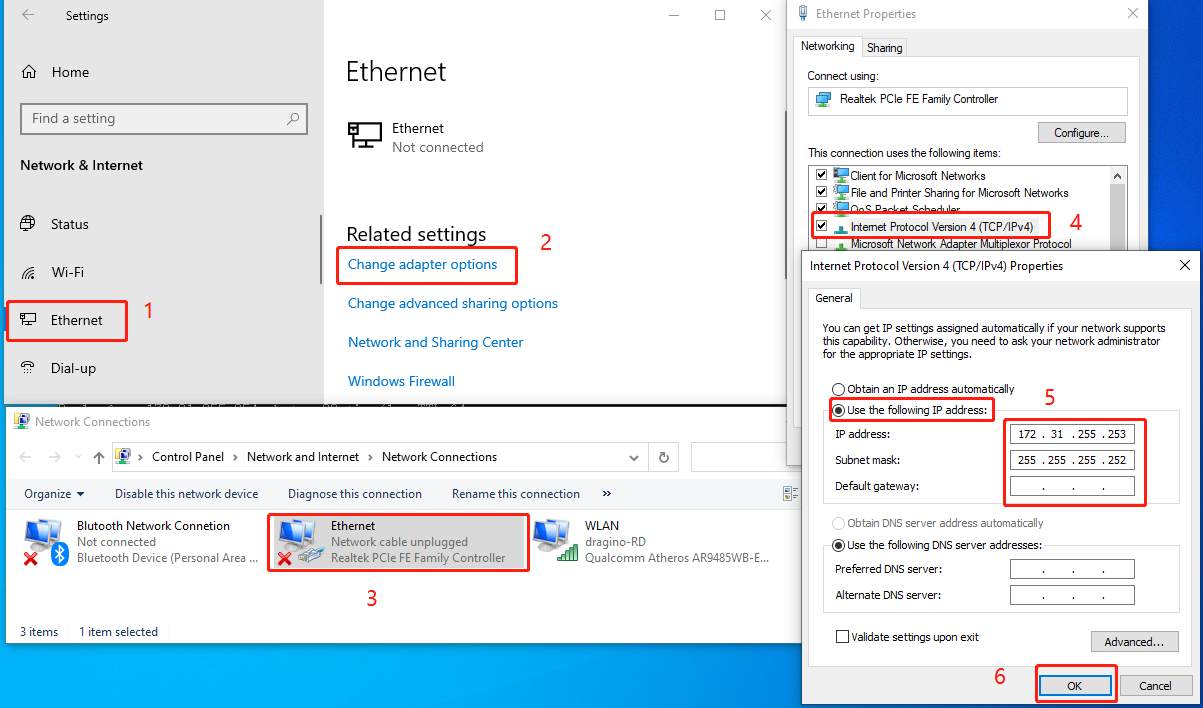
Configure computer Ethernet port steps video: fallback ip.mp4
If you still can't access the LG01v2 fallback ip, follow this connection to debug : Trouble Shooting
3. In the PC, use IP address 172.31.255.254 to access the LG01v2 via Web or Console.

Method 3: Connect via WiFi with DHCP IP from the router

Fill in the WiFi information by checking the box and clicking Save&Apply

Wi-Fi configuration successful

2.1.2 Access Configure Web UI
Web Interface
Open a browser on the PC and type the LG01v2 ip address (depends on your connect method)
http://IP_ADDRESS or http://172.31.255.254(Fallback IP)
You will see the login interface of LG01v2 as shown below.
The account details for Web Login are:
User Name: root
Password: dragino
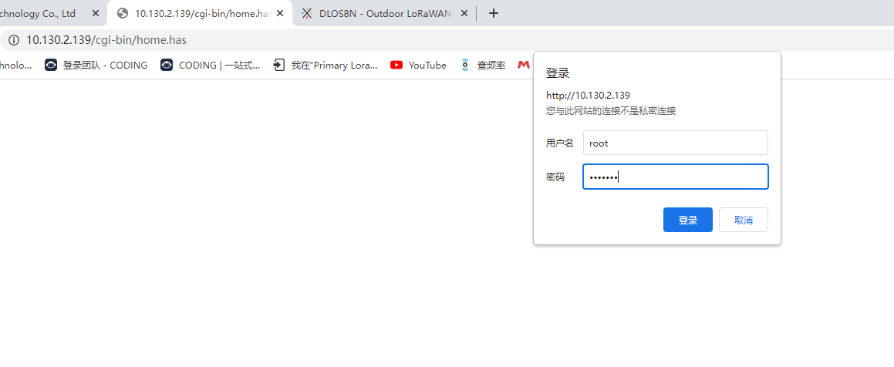
3. Web Configure Pages
3.1 Home
Shows the system running status:

3.2 Network Settings
3.2.1 Network --> WiFi

3.4.2 Network --> System Status

3.5 System
3.5.1 System --> System Overview
Shows the system info:

3.5.2 System --> Backup/Restore

3.5.3 System --> System General
In the System-> System General interface, Users can customize the configuration System Password and set Timezone.
In addition, Users can customize the FallBack IP address.

3.5.4 System --> Remoteit
In the System-> Remoteit interface, users can configure the gateway to be accessed remotely via Remote.it.
the users can refer to this link to configure them: Monitor & Remote Access Gateway

3.5.5 System --> Package Management
In the System --> Package Management interface, Users can check the current version of Core Packages.

4. Build in Server
The default factory version of LG01-V2 is installed with the built-in Applicant server: Node-Red

Note:
Path: System --> Built-in Server
Troubleshooting:
1. URL does not jump properly
For the Node-Red, you can use the local IP address and the port is 1880 to access it.
4.1 Application Server -- Node-Red
You can access the gateway's built-in AS server of Node-Red via the URL(http://<hostname>:1880 or http://<local-IPV4-address>) in your browser.
Such as http://dragino-54ff12:1880 or http://<Local-IPV4-Address>
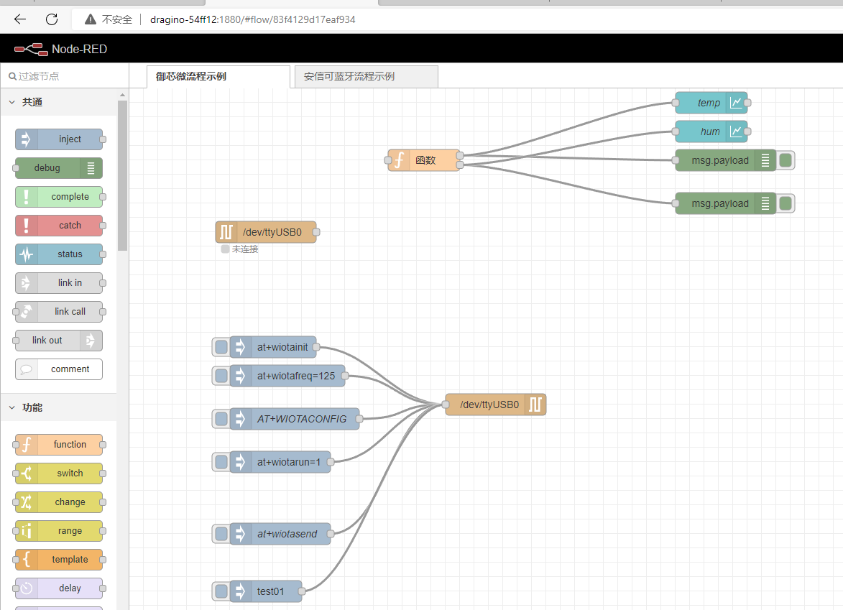
5. How to configure the Lora Gateway
5.1 Configure and Debug LoRa wireless of LG01v2
First, the user needs to access the Linux console of LG01v2 via ssh
IP address: IP address of LG01v2
Port: 22
User Name: root
Password: dragino(default)

Users can access the Lora configuration page by running the following command, then select the option ''serial port setup":

And then, change the setting:
Note: Enter the corresponding letter to change the configuration, like A,B,C

Enter AT+CFG in the interface to get the configuration,
5.2 Example: LG01v2
5.2.1 Introduce for the example:

In this example, there are two devices:
- LA66 Shield + UNO + DHT11: The UNO will get the temperature and humidity and broadcast the value via LoRa protocol.
- LG01v2 : LG01v2 is set to listening the LoRa Channel which LA66 is broadcasting. When LG01v2 get the data from LA66, LG01v2 will plot the data in built-in IoT server.
5.2.2 Set Up LA66 Shield + UNO
Set up LA66 Module
LA66 Module is loaded with the firmware LA66 Peer-to-Peer firmware and user can use AT Command to set up LA66 with below parameters:
LA66 Shield as Sender:
Set up Arduino UNO
Hardware Connection

1. Open Arduino IDE

2. Open project
Users can download Arduino files from this link:
Then click Compile and Upload to LA66 Shield,

3. Open the Serial Monitor to check the LA66 Shield data
The UNO will now reads the temperature and humidity data from the sensor and broadcast it via LoRa wireless,

Sending out data as below.

5.2.3 Set Up LG01v2
Configure LG01v2 LoRa channel parameters so it can get data from LA66 Shield
LG01v2 as Receiver: (configured as AT+RXMOD=65535,2)
5.2.4 Test result
After the above configuration is complete, users can send test simulation data to check whether the configuration is correct, In LA66 sheild serial console send:(AT+SEND=1,hello world,2,3).
When LG01v2 replies with ACK when it receives a packet sent by LA66 sheild.

In the real-time log of LG01v2:

5.2.5 Plot data chart in LG01v2
User can plot the temperature and humidity chat via LG01v2 built-in IoT server.
User can import this example in Node-Red:

The temperature and humidity chart is displayed in the built-in node-red UI
Browser input: http://<local-IPV4-address>

6. OTA System Update
LG01v2 supports system auto update via OTA, please see this URL for the detail of this feature.
7. How users can access LG01v2 using serial USB
USB TTL to LG01v2 Connection:
Port 1 of the UART on the LG01v2 is GND
LG01v2 UART connection photo

In the PC,you can use the serial port tool(such as putty in Windows), you need to set the serial baud rate to 115200 to access the serial console for LPS8v2. LPS8v2 will output system info once power on as below:


8. FAQ
8.1 How does LG01v2 communicate with Lora shield (LoRa.h)
This example describes how to use LG01v2, LoRa Shield to set up a LoRa network,

Prerequisites: The configurations of LG01v2 and Lora shield must match
LG01v2 configuration:
Lora shield configuration:
Lora Shield example: ,

Test LG01v2 to receive Lora Shield data:

Test the LG01v2 to send data:

8.2 How does LG01v2 communicate with Heltec LoRa Node
This example describes how to use LG01v2 and Heltec LoRa Node to set up a LoRa network,

Prerequisites: The configurations of LG01v2 and Lora shield must match
LG01v2 configuration:
After we upload the sketch to Heltec LoRa Node, we can see below output from Arduino.
Lora Shield example:

And we can see the logread of gateway as below, means the packet arrive gateway:

8.3 How does LG01v2 communicate with LoRaWAN node
This example describes how to use LG01v2 and LSN50 to set up a network,
In this case, users need to set LSN50 to work in ABP mode and transmit in only one frequency.
Assume we have a LG01v2 working in the frequency 868100000 now, below is the steps.
Step1: Configure the LG01v2
Step2: Run AT commands to make the LSN50 work in Single frequency and ABP mode.
For more information on how to use AT commands in LSN50v2, please refer to this link: LSN50v2-S31-S31B Use AT Command
Below are the AT commands:
Step3: Check result
User can plot the temperature and humidity chat via LG01v2 built-in IoT server.
User can import this example in Node-Red:
First the user needs to fill in the NwkSkey and AppSkey in the LoraWan Packet Decrypter node.


The data will be displayed in the built-in node-red UI
Browser input: http://<local-IPV4-address>

8.4 How can users factory reset LG01v2
Users can download the image of LG01v2 from this link:dragino-lg01v2-1.7-0210
Then follow the steps in the link below to restore factory Settings to LG01v2:
How to flash a new image(OS) to the gateway
9. Trouble Shooting
9.1 Fallback IP does not work, how can users check
When the computer has completed the above fallback IP configuration,the LG01v2 Web UI is still not accessible via fallback IP.
1.Check whether the configuration is correct
Run the CMD command to ipconfig and ping 172.31.255.254.
If this fails, the user needs to reconfigure.
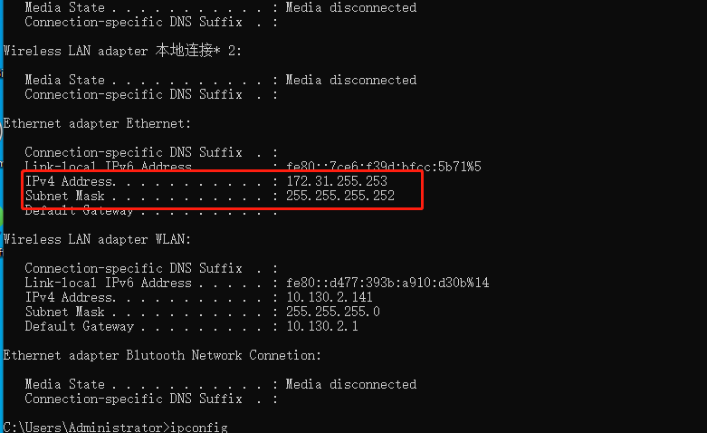
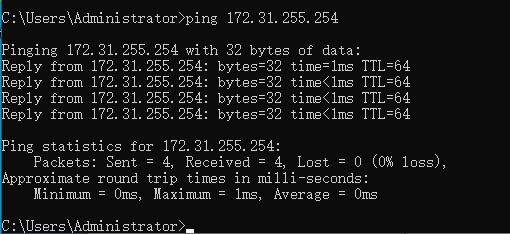
2. Check whether the firewall is disabled
If the firewall is not down, this will affect access to the gateway.
10. Supports
If you are experiencing issues and can't solve them, you can send mail to support@dragino.com.
With your question as detailed as possible. We will reply and help you in the shortest.
11. Reference
- Install Tago Core: Refer Install Tago Core in LG01v2 in Instruction.
12. Order Info
LG01v2-XXX-YYY
XXX: Frequency Band
- 868: For frequency : 863 ~ 870Mhz
- 915: For frequency : 902 ~ 928Mhz
YYY: 4G Cellular Option
- EC25-E: EMEA, Korea, Thailand, India
- EC25-AFX: America: Verizon, AT&T(FirstNet), U.S.Cellular; Canada: Telus
- EC25-AUX: Latin America, New Zeland, Taiwan
- EC25-J: Japan, DOCOMO, SoftBank, KDDI
More info about valid bands, please see EC25-E product page.
13. Manufacturer Info
Shenzhen Dragino Technology Development co. LTD
Room 202, Block B, BCT Incubation Bases (BaoChengTai), No.8 CaiYunRoad
LongCheng Street, LongGang District ; Shenzhen 518116,China
14. FCC Warning
This equipment has been tested and found to comply with the limits for a Class B digital device, pursuant to Part 15 of the FCC Rules. These limits are designed to provide reasonable protection against harmful interference in a residential installation. This equipment generates uses and can radiate radio frequency energy and, if not installed and used in accordance with the instructions, may cause harmful interference to radio communications. However, there is no guarantee that interference will not occur in a particular installation. If this equipment does cause harmful interference to radio or television reception, which can be determined by turning the equipment off and on, the user is encouraged to try to correct the interference by one or more of the following measures:
-- Reorient or relocate the receiving antenna.
-- Increase the separation between the equipment and receiver.
-- Connect the equipment into an outlet on a circuit different from that to which the receiver is connected.
-- Consult the dealer or an experienced radio/TV technician for help.
Changes or modifications not expressly approved by the party responsible for compliance could void the user's authority to operate the equipment.
The antenna(s) used for this transmitter must be installed to provide a separation distance of at least 20 cm from all persons and must not be co-located or operating in conjunction with any other antenna or transmitter.
